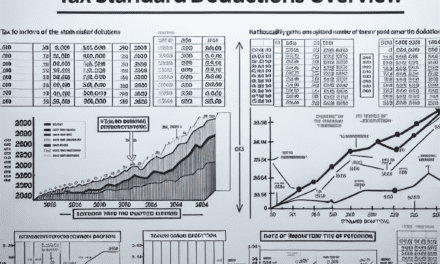“Broader Horizons, Elusive Gains: S&P’s Rally Beyond Tech”
Introduction
The recent expansion of the S&P 500 rally beyond the technology sector marks a significant shift in market dynamics, as investors diversify their focus across a broader range of industries. This development comes after a prolonged period where tech stocks dominated market gains, driven by rapid innovation and digital transformation trends. However, despite this broadened rally, the anticipated profit growth across the index remains elusive. Various sectors face challenges such as supply chain disruptions, inflationary pressures, and geopolitical uncertainties, which continue to weigh on earnings potential. As a result, while the rally’s expansion suggests increased investor confidence and a more balanced market, the underlying issue of stagnant profit growth poses questions about the sustainability of these gains.
Broader Market Participation: S&P Rally Extends Beyond Tech
The recent rally in the S&P 500 has captured the attention of investors and analysts alike, as it has expanded beyond the technology sector, which has traditionally been the primary driver of market gains. This broader market participation is a significant development, suggesting a more diversified and potentially sustainable upward trend. However, despite this expansion, the anticipated profit growth that typically accompanies such rallies remains elusive, raising questions about the underlying strength of the current market dynamics.
Initially, the technology sector was the undisputed leader in the S&P 500’s ascent, buoyed by robust earnings and the increasing integration of technology into various aspects of daily life. Companies within this sector benefited from accelerated digital transformation trends, which were further amplified by the global pandemic. As a result, tech stocks experienced substantial gains, often overshadowing other sectors. However, recent months have seen a shift, with other sectors such as healthcare, consumer discretionary, and financials beginning to contribute more significantly to the index’s performance.
This diversification in market leadership is a welcome development for investors seeking to mitigate risk. A rally driven by multiple sectors is generally considered more stable, as it is less vulnerable to sector-specific downturns. For instance, the healthcare sector has gained momentum due to increased demand for medical services and innovations in biotechnology. Similarly, consumer discretionary stocks have benefited from a resurgence in consumer spending as economies reopen and consumer confidence improves. Financials, on the other hand, have been buoyed by rising interest rates, which enhance the profitability of lending activities.
Despite these positive developments, the anticipated profit growth that typically accompanies such a broad-based rally has yet to materialize. Analysts have noted that while revenues have increased across various sectors, profit margins have been under pressure due to rising costs. Inflationary pressures, supply chain disruptions, and labor shortages have all contributed to increased operational expenses, which have, in turn, eroded profit margins. Consequently, while top-line growth has been encouraging, bottom-line improvements have lagged behind.
Moreover, the macroeconomic environment remains fraught with uncertainties that could impact future profit growth. Central banks worldwide are grappling with the challenge of curbing inflation without stifling economic growth. Interest rate hikes, while necessary to control inflation, could dampen consumer spending and business investment, thereby affecting corporate earnings. Additionally, geopolitical tensions and trade disruptions continue to pose risks to global supply chains, further complicating the profit outlook for multinational corporations.
In light of these challenges, investors are advised to exercise caution and maintain a diversified portfolio. While the broader market participation in the S&P 500 rally is a positive sign, the absence of corresponding profit growth suggests that the market may be vulnerable to corrections. It is essential for investors to remain vigilant and consider both macroeconomic indicators and company-specific fundamentals when making investment decisions.
In conclusion, the expansion of the S&P 500 rally beyond the technology sector marks a significant shift in market dynamics, offering a more balanced and potentially resilient growth trajectory. However, the lack of substantial profit growth underscores the complexities of the current economic landscape. As the market navigates these challenges, investors must remain informed and adaptable, recognizing that while broader participation is promising, it does not guarantee sustained profitability.
Sector Diversification: Analyzing the S&P’s Expanding Rally
The recent expansion of the S&P 500 rally beyond the technology sector marks a significant shift in market dynamics, reflecting a broader investor confidence in the economic recovery. Traditionally, the technology sector has been the primary driver of the S&P 500’s performance, buoyed by rapid innovation and robust earnings growth. However, as the rally extends into other sectors, it suggests a diversification that could potentially stabilize the index against sector-specific volatility. This shift is particularly noteworthy as it comes at a time when profit growth remains elusive, posing questions about the sustainability of this broader market enthusiasm.
In recent months, sectors such as consumer discretionary, financials, and industrials have shown remarkable resilience, contributing to the S&P 500’s upward trajectory. This diversification is partly attributed to the gradual reopening of economies and the subsequent increase in consumer spending. As consumers regain confidence, companies in these sectors are experiencing a surge in demand, which is reflected in their stock performance. Moreover, the financial sector has benefited from rising interest rates, which have improved profit margins for banks and other financial institutions. This sectoral rotation indicates that investors are seeking opportunities beyond the high-growth technology stocks that have dominated the market landscape for years.
Despite this positive development, the challenge of achieving substantial profit growth persists. Many companies are grappling with supply chain disruptions, rising input costs, and labor shortages, which have collectively exerted pressure on profit margins. These issues are particularly pronounced in sectors that are heavily reliant on global supply chains, such as industrials and consumer goods. Consequently, while stock prices have risen, actual profit growth has lagged, raising concerns about the disconnect between market valuations and underlying economic fundamentals.
Furthermore, the current macroeconomic environment presents additional hurdles. Inflationary pressures continue to mount, driven by a combination of factors including increased consumer demand, supply chain bottlenecks, and geopolitical tensions. Central banks worldwide are navigating the delicate balance between curbing inflation and supporting economic growth, with interest rate hikes being a tool of choice. However, higher interest rates could dampen consumer spending and business investment, potentially stalling the economic recovery and impacting corporate earnings.
In light of these challenges, investors are increasingly focusing on companies with strong balance sheets and the ability to navigate economic uncertainties. This shift in investment strategy underscores the importance of financial resilience and operational efficiency in sustaining long-term growth. Companies that can adapt to changing market conditions and effectively manage costs are likely to emerge as leaders in this evolving landscape.
As the S&P 500 rally broadens, it is crucial for investors to remain vigilant and discerning. While sector diversification offers a buffer against market volatility, the underlying issues of profit growth and economic stability cannot be overlooked. The interplay between market optimism and economic reality will continue to shape investment strategies and influence market outcomes. Therefore, a comprehensive understanding of both sector-specific dynamics and broader economic trends is essential for navigating this complex environment.
In conclusion, the expansion of the S&P 500 rally beyond the technology sector is a promising development, reflecting a more balanced market approach. However, the persistent challenge of achieving robust profit growth amidst economic uncertainties necessitates a cautious and informed investment strategy. As the market continues to evolve, staying attuned to both opportunities and risks will be key to capitalizing on this diversified rally.
Profit Growth Challenges Amidst S&P’s Broadening Rally
The recent expansion of the S&P 500 rally beyond the technology sector has captured the attention of investors and analysts alike. While the initial surge was predominantly driven by tech giants, the rally has now broadened to include a more diverse array of sectors. This diversification is a positive sign for the market, suggesting a more balanced and sustainable growth trajectory. However, despite this encouraging development, the challenge of achieving substantial profit growth remains a significant hurdle for many companies within the index.
To begin with, the initial phase of the S&P 500 rally was largely fueled by the impressive performance of technology companies. These firms, benefiting from rapid digital transformation and increased demand for tech solutions, saw their valuations soar. As a result, the tech sector became the primary driver of the index’s upward momentum. However, as the rally has expanded, other sectors such as healthcare, consumer goods, and financials have started to contribute more significantly to the overall market performance. This shift indicates a healthier market dynamic, as reliance on a single sector can lead to vulnerabilities and increased volatility.
Despite this broader participation, the challenge of translating market gains into tangible profit growth persists. Many companies are grappling with a complex economic environment characterized by rising costs, supply chain disruptions, and geopolitical uncertainties. These factors have put pressure on profit margins, making it difficult for firms to achieve the kind of earnings growth that would justify their elevated stock prices. Consequently, while stock prices have risen, actual profit growth has lagged behind, creating a disconnect that could pose risks to the sustainability of the rally.
Moreover, inflationary pressures have further complicated the profit growth landscape. As costs for raw materials, labor, and transportation continue to rise, companies are faced with the difficult decision of whether to absorb these costs or pass them on to consumers. In many cases, firms have opted for the latter, leading to higher prices for goods and services. However, this strategy carries its own risks, as it can dampen consumer demand and ultimately impact sales volumes. Thus, companies must navigate a delicate balance between maintaining profitability and preserving customer loyalty.
In addition to these challenges, the global economic outlook remains uncertain. While some regions are experiencing robust recovery, others are still grappling with the lingering effects of the pandemic. This uneven recovery has implications for multinational corporations, which must adapt their strategies to varying market conditions. Furthermore, geopolitical tensions and trade disputes continue to pose risks to global supply chains and economic stability, adding another layer of complexity to the profit growth equation.
In conclusion, while the broadening of the S&P 500 rally beyond the technology sector is a positive development, the path to sustained profit growth remains fraught with challenges. Companies must contend with rising costs, inflationary pressures, and an uncertain global economic environment. As such, investors should remain vigilant and consider these factors when evaluating the long-term prospects of their portfolios. Ultimately, the ability of companies to navigate these challenges and achieve meaningful profit growth will be a key determinant of the rally’s sustainability and the overall health of the market.
Tech’s Influence Diminishes: S&P Rally Gains Wider Support

The recent rally in the S&P 500 has captured the attention of investors and analysts alike, as it marks a significant shift in market dynamics. Traditionally dominated by the tech sector, this rally has expanded its reach, drawing strength from a broader array of industries. This diversification is a welcome development for those concerned about the market’s over-reliance on technology stocks. However, despite this broader participation, the anticipated profit growth remains elusive, raising questions about the sustainability of the rally.
In recent years, technology companies have been the primary drivers of the S&P 500’s performance, with giants like Apple, Microsoft, and Amazon leading the charge. Their dominance has been fueled by rapid innovation, strong consumer demand, and the digital transformation of various sectors. However, as the rally extends beyond tech, other sectors such as healthcare, consumer goods, and financials are beginning to play a more prominent role. This shift is partly due to investors seeking opportunities in undervalued areas and partly due to the natural ebb and flow of market cycles.
The healthcare sector, for instance, has seen increased investor interest as companies within this space continue to innovate and adapt to changing demographics and healthcare needs. Similarly, consumer goods companies are benefiting from a resurgence in consumer spending, driven by a robust labor market and rising wages. Financials, too, are gaining traction as interest rates stabilize, providing a more favorable environment for banks and other financial institutions to thrive.
Despite this broader market participation, the anticipated profit growth that typically accompanies such rallies has yet to materialize. Several factors contribute to this phenomenon. First, the global economic landscape remains fraught with uncertainty. Geopolitical tensions, trade disputes, and fluctuating commodity prices continue to pose challenges to sustained economic growth. These uncertainties can dampen corporate investment and consumer confidence, ultimately impacting profit margins.
Moreover, inflationary pressures have been a persistent concern, eroding purchasing power and increasing operational costs for businesses. While central banks have taken measures to address inflation, the effects of these policies are not immediate, and companies may continue to face margin pressures in the short term. Additionally, supply chain disruptions, although easing, still present hurdles for many industries, further complicating efforts to achieve profit growth.
Another factor to consider is the high valuation levels that many stocks have reached. As prices rise, the potential for future returns diminishes, making it challenging for companies to deliver the profit growth necessary to justify these valuations. This situation is particularly pronounced in the tech sector, where valuations have soared to unprecedented levels, prompting some investors to question the sustainability of such high prices.
In conclusion, while the S&P 500’s rally expanding beyond the tech sector is a positive development, it is not without its challenges. The lack of corresponding profit growth raises concerns about the rally’s durability and the broader economic environment’s ability to support sustained market gains. Investors must remain vigilant, balancing optimism with caution as they navigate this complex landscape. As the market continues to evolve, the interplay between sector diversification and profit growth will be crucial in determining the future trajectory of the S&P 500.
Economic Indicators: S&P Rally’s Expansion Without Profit Growth
The recent expansion of the S&P 500 rally beyond the technology sector has captured the attention of investors and analysts alike. Traditionally, the technology sector has been the primary driver of market gains, with companies like Apple, Microsoft, and Amazon leading the charge. However, the current rally has seen a broader range of sectors participating, suggesting a shift in market dynamics. Despite this diversification, a notable concern remains: the anticipated profit growth that typically accompanies such rallies has yet to materialize.
To understand this phenomenon, it is essential to examine the factors contributing to the rally’s expansion. One significant element is the gradual recovery of the global economy from the disruptions caused by the COVID-19 pandemic. As vaccination rates increase and restrictions ease, consumer confidence has improved, leading to a resurgence in spending across various sectors. This renewed economic activity has provided a boost to industries such as consumer discretionary, financials, and industrials, which had previously lagged behind technology in terms of performance.
Moreover, fiscal and monetary policies have played a crucial role in supporting the broader market rally. Central banks around the world have maintained accommodative monetary policies, keeping interest rates low and providing liquidity to financial markets. Concurrently, government stimulus measures have injected capital into the economy, further bolstering consumer spending and business investment. These factors have created a favorable environment for a wide range of sectors to thrive, contributing to the expansion of the S&P 500 rally.
However, despite the positive momentum, the lack of corresponding profit growth raises questions about the sustainability of the rally. While revenues have increased for many companies, profit margins have been under pressure due to rising costs. Supply chain disruptions, labor shortages, and inflationary pressures have all contributed to higher input costs, which have not been fully offset by price increases. As a result, many companies have struggled to translate revenue gains into profit growth, leading to concerns about the long-term viability of the current market rally.
Furthermore, the disparity between stock price appreciation and profit growth has led to elevated valuation levels. Investors have been willing to pay a premium for stocks, driven by optimism about future growth prospects and the belief that current challenges are temporary. However, if profit growth does not materialize as expected, these high valuations could become difficult to justify, potentially leading to market volatility.
In light of these considerations, investors are closely monitoring upcoming earnings reports and economic indicators for signs of improvement in profit margins. Companies that can effectively manage costs and demonstrate sustainable profit growth are likely to be rewarded by the market. Conversely, those that continue to face margin pressures may experience increased scrutiny and potential downward pressure on their stock prices.
In conclusion, while the expansion of the S&P 500 rally beyond the technology sector is a positive development, the absence of corresponding profit growth remains a significant concern. The interplay between economic recovery, fiscal and monetary policies, and company-specific factors will be critical in determining the rally’s sustainability. As investors navigate this complex landscape, a focus on fundamentals and a cautious approach to valuation will be essential in identifying opportunities and managing risks.
Investment Strategies: Navigating the S&P’s Diverse Rally
The recent rally in the S&P 500 has captured the attention of investors and analysts alike, as it has expanded beyond the technology sector, which has traditionally been the primary driver of market gains. This diversification of growth across various sectors presents both opportunities and challenges for investors seeking to navigate the complexities of the current market environment. While the broadening of the rally is a positive sign, indicating a more balanced market, it is important to note that profit growth remains elusive for many companies, posing a significant challenge for investment strategies.
Initially, the technology sector was the undisputed leader in driving the S&P 500’s performance, fueled by rapid innovation and the increasing digitalization of the global economy. However, as the rally has progressed, other sectors such as healthcare, consumer discretionary, and industrials have begun to contribute more significantly to the index’s gains. This shift suggests a more robust and sustainable market environment, as reliance on a single sector can lead to vulnerabilities and increased volatility. Consequently, investors are now presented with a wider array of opportunities to diversify their portfolios and mitigate risk.
Despite this positive development, the challenge of achieving profit growth remains a critical concern. Many companies across various sectors are grappling with rising costs, supply chain disruptions, and geopolitical uncertainties, which have collectively hindered their ability to translate revenue growth into increased profitability. As a result, investors must exercise caution and conduct thorough due diligence when selecting stocks, as not all companies will be able to navigate these challenges successfully.
In light of these complexities, a strategic approach to investment is essential. One potential strategy is to focus on companies with strong balance sheets and a proven track record of navigating economic headwinds. These companies are more likely to weather the current challenges and emerge stronger in the long term. Additionally, investors may consider exploring sectors that are poised for growth due to structural changes in the economy, such as renewable energy and healthcare innovation. These sectors offer potential for long-term growth, driven by increasing demand and supportive policy environments.
Moreover, it is crucial for investors to remain vigilant and adaptable, as market conditions can change rapidly. Keeping abreast of macroeconomic indicators, such as interest rates and inflation, can provide valuable insights into potential market shifts. Furthermore, maintaining a diversified portfolio can help mitigate risks associated with sector-specific downturns, ensuring a more stable investment journey.
In conclusion, while the expansion of the S&P 500 rally beyond the technology sector is a welcome development, the challenge of achieving profit growth remains a significant hurdle for many companies. Investors must navigate this complex landscape with a strategic and informed approach, focusing on companies with strong fundamentals and sectors with promising growth prospects. By doing so, they can position themselves to capitalize on the opportunities presented by the current market environment while mitigating potential risks. As always, staying informed and adaptable will be key to successfully navigating the diverse rally of the S&P 500.
Market Dynamics: Understanding the S&P’s Rally Beyond Tech
The recent rally in the S&P 500 has captured the attention of investors and analysts alike, as it has expanded beyond the technology sector, traditionally seen as the primary driver of market gains. This broadening of the rally is a significant development, suggesting a shift in market dynamics that could have far-reaching implications for investment strategies. However, despite this expansion, the anticipated profit growth remains elusive, raising questions about the sustainability of the current market trends.
Initially, the technology sector was the undisputed leader in the S&P 500’s upward trajectory, fueled by robust earnings reports and the increasing reliance on digital solutions across various industries. Companies within this sector benefited from accelerated digital transformation initiatives, which were further propelled by the global pandemic. As a result, tech stocks experienced substantial gains, contributing significantly to the overall performance of the index. Nevertheless, as the rally extends beyond technology, other sectors are beginning to play a more prominent role.
Industries such as healthcare, consumer discretionary, and financials have started to show signs of strength, indicating a more diversified market rally. This diversification is crucial as it suggests that investors are gaining confidence in the broader economic recovery, rather than relying solely on the tech sector’s performance. The healthcare sector, for instance, has seen increased investor interest due to advancements in biotechnology and pharmaceuticals, as well as the ongoing demand for healthcare services. Similarly, consumer discretionary stocks have benefited from a resurgence in consumer spending, driven by pent-up demand and improved economic conditions.
Moreover, the financial sector has also contributed to the rally, buoyed by rising interest rates and a more favorable regulatory environment. Banks and financial institutions are experiencing improved profit margins as interest rates climb, enhancing their appeal to investors seeking value outside the technology sphere. This shift in investor sentiment is indicative of a broader market confidence that extends beyond the tech-driven narrative.
Despite these positive developments, the anticipated profit growth across the S&P 500 remains out of reach. While the rally has expanded, actual earnings growth has not kept pace with market valuations. This disconnect raises concerns about the sustainability of the current rally, as high valuations without corresponding profit growth could lead to increased market volatility. Investors are becoming increasingly cautious, aware that the market’s optimism may not be fully supported by underlying fundamentals.
Furthermore, external factors such as geopolitical tensions, inflationary pressures, and potential changes in monetary policy add layers of complexity to the market outlook. These elements could impact corporate profitability and investor sentiment, further complicating the path to sustained profit growth. As a result, market participants are closely monitoring these developments, seeking to balance optimism with prudence.
In conclusion, while the S&P 500’s rally beyond the technology sector is a promising sign of market diversification and broader economic recovery, the lack of corresponding profit growth remains a critical concern. Investors must navigate this complex landscape with a keen eye on both opportunities and risks, as the interplay between market dynamics and economic fundamentals continues to evolve. As the rally progresses, the ability to adapt to changing conditions will be paramount in achieving long-term investment success.
Q&A
1. **What is the S&P 500 rally?**
The S&P 500 rally refers to the significant increase in the index’s value, indicating a rise in stock prices across the companies listed in the S&P 500.
2. **Which sectors are contributing to the S&P 500 rally beyond tech?**
Sectors such as consumer discretionary, industrials, and financials have contributed to the rally beyond the technology sector.
3. **Why is profit growth still out of reach despite the rally?**
Profit growth remains elusive due to factors like high inflation, rising interest rates, and ongoing supply chain disruptions, which impact corporate earnings.
4. **How have interest rates affected the S&P 500 rally?**
Rising interest rates can dampen stock market rallies by increasing borrowing costs and reducing consumer spending, which can negatively impact company profits.
5. **What role does consumer spending play in the S&P 500 rally?**
Consumer spending drives demand for goods and services, boosting revenues for companies and contributing to stock price increases, thus supporting the rally.
6. **Are there any risks to the sustainability of the S&P 500 rally?**
Risks include potential economic slowdowns, geopolitical tensions, and further interest rate hikes, which could negatively impact market sentiment and stock prices.
7. **What strategies are investors using in response to the current market conditions?**
Investors are diversifying their portfolios, focusing on value stocks, and considering defensive sectors to mitigate risks associated with market volatility.
Conclusion
The S&P 500’s rally extending beyond the technology sector indicates a broadening market recovery, suggesting increased investor confidence and diversification of growth prospects. However, the persistent lack of profit growth highlights underlying economic challenges and potential vulnerabilities. This disconnect between market performance and corporate earnings could signal caution for investors, as sustained market gains may be difficult to maintain without corresponding improvements in profitability.





